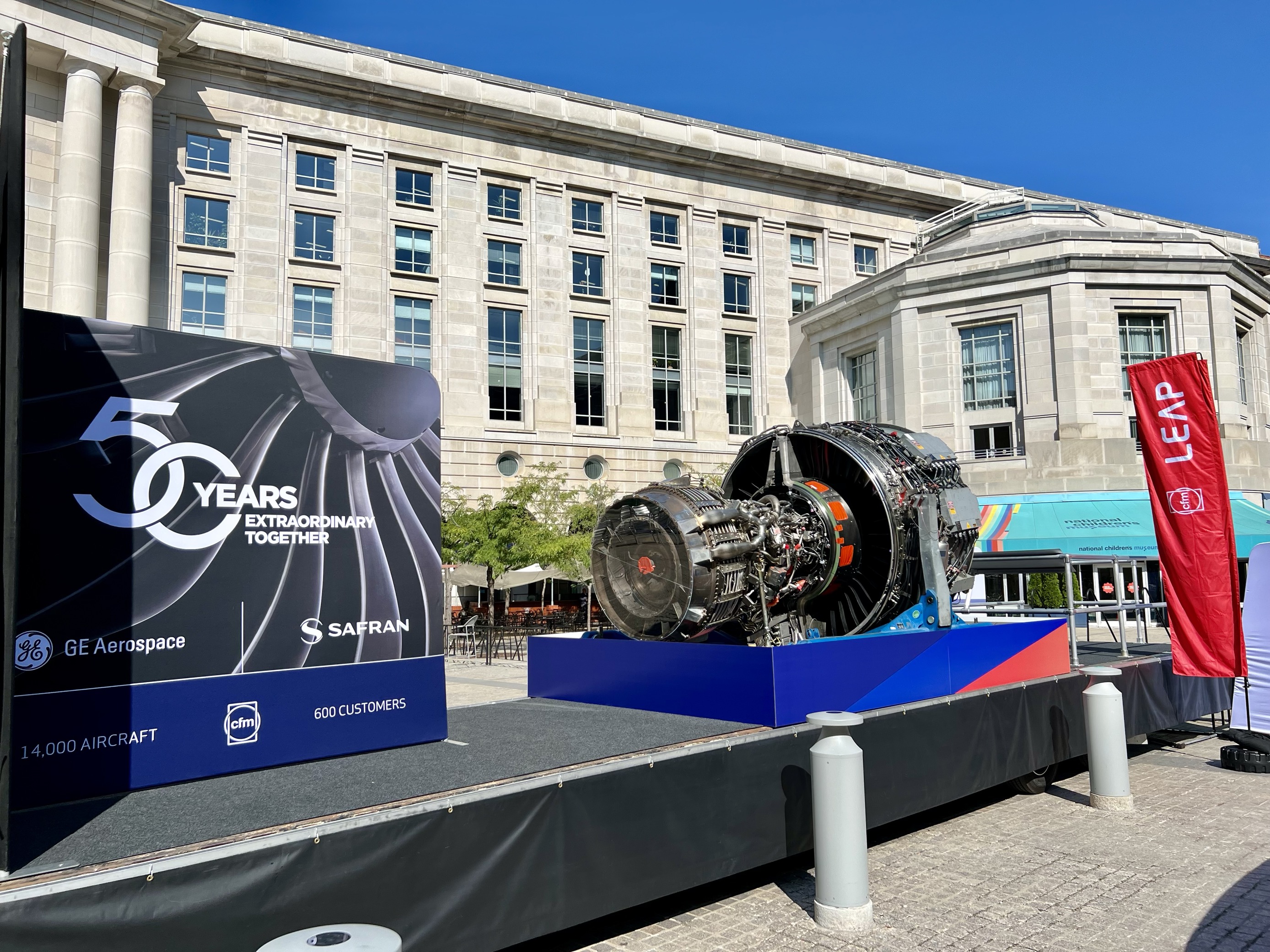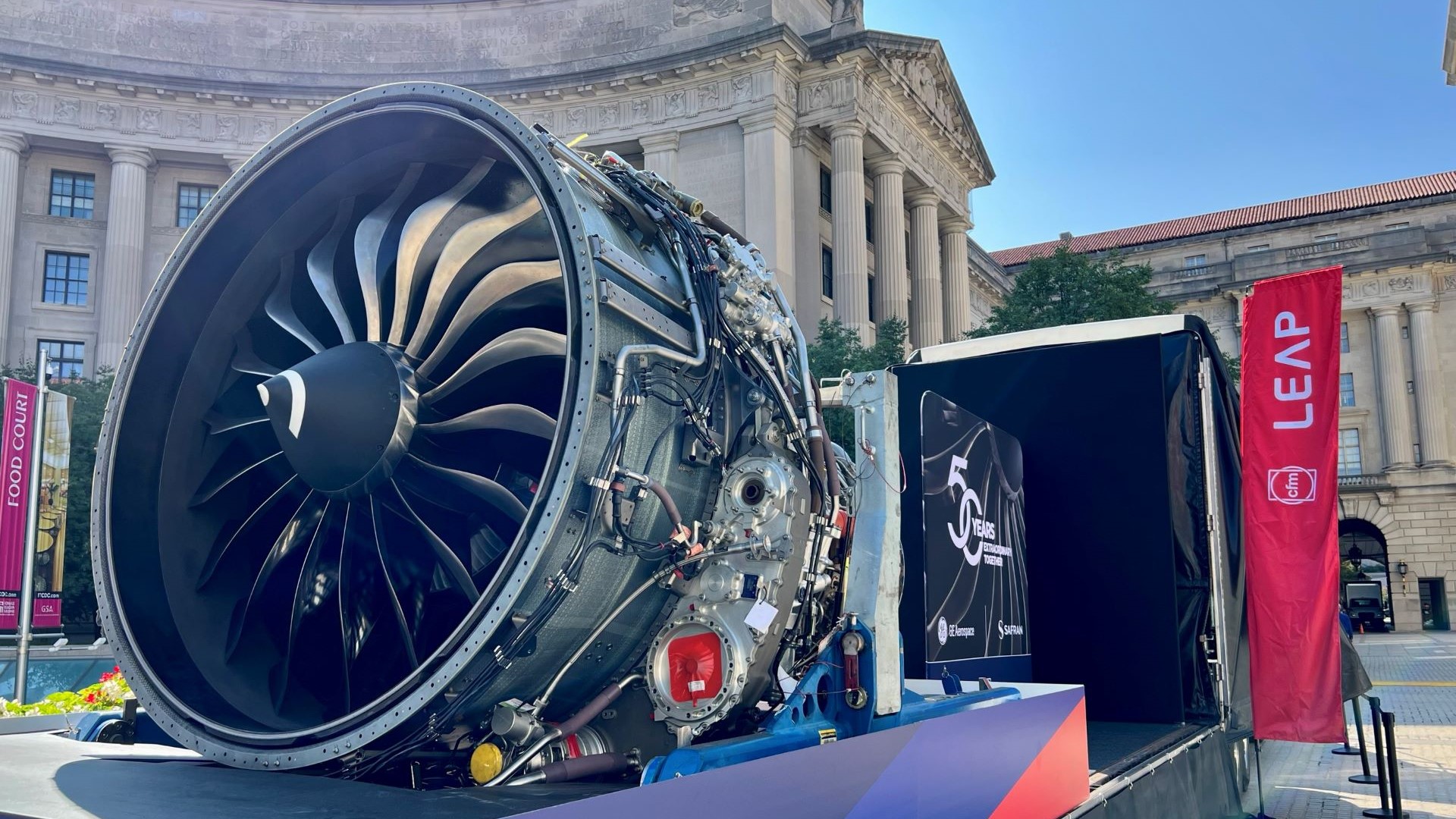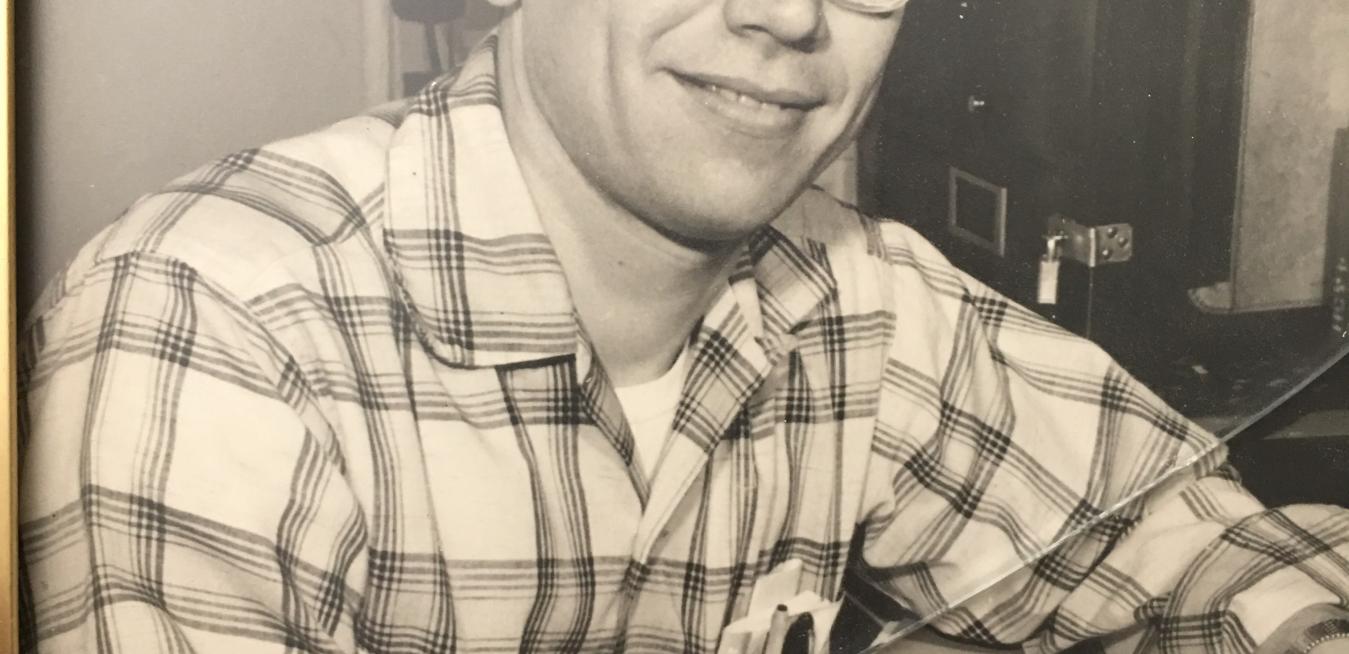Three Tons of Fun: CFM LEAP Engine Goes on Tour to Thank Employees (and Attract Some New Ones)
October 16, 2024 | by Chris Norris
The truck-mounted CFM LEAP engine that just set out on a road trip to colleges and GE Aerospace sites around the country packs some of aviation’s most advanced technology into a single 6,000-pound showstopper. “It’s a tangible example of everything we do behind the scenes,” says LEAP Assembly Engineer David Slakes, who oversaw preparations to make the LEAP engine road-ready for a singular mission: getting this exemplar of aerospace excellence out in front of current —and possibly some future — workers in aviation.
The tour also commemorates the 50-year partnership between GE Aerospace and Safran Aircraft Engines, which co-founded CFM International as a 50-50 joint company in 1974. CFM began by producing the CFM56 engine to bring better fuel efficiency and lower noise to the single-aisle (150-passenger) aircraft market. Over time, it became the world’s best-selling jet engine. Then, in 2016, the CFM LEAP engine debuted, commencing the biggest ramp-up in engine production in the company’s history. When the 18-wheeler pulls into a tour stop, the LEAP engine pretty much speaks for itself: the shimmering black walls of the trailer bed retract, revealing the dynamo mounted on a stand, looking like Indiana Jones’ Ark of the Covenant.
The CFM LEAP Engine on College Campuses
“It’s really awesome for students to show up on a campus quad and see a nearly six-foot-tall commercial engine up close and personal,” says Alissa Friedman, who serves as U.S. early careers recruiting leader on the company’s Talent Acquisition team. “It’s a real-life teaching tool, sparking curiosity, smart questions, and, yes, loads of selfies!” At each campus visit, GE Aerospace reps also highlight opportunities for internships, leadership programs, and postgraduate roles at the company.
The 30-stop tour began on September 8 in Washington, D.C., and will continue through the Northeast, the Midwest, and the South, splitting visits almost equally between company sites and universities before finishing up in Mississippi in November. From there the engine will head back to GE Aerospace’s headquarters in Evendale, Ohio, for some post-tour maintenance, then eventually return to France to resume ground testing.
Although it will never be used on a commercial passenger jet, this LEAP engine — known internally as “104,” the last three digits of its serial number — needed a fair amount of loving attention before it left home. “It’s a real ground test engine and it had run live tests in France before they shipped it over here,” Slakes explains. In Evendale, Slakes’ team first swapped in a set of scrap fan blades. “Then we painted those blades black and put on a new spinner cone,” he adds. And since the engine will head back to France after the tour, they also conducted a borescope inspection of its interior, both to document its pre-tour condition and to provide the Federal Aviation Administration with a conforming report to affirm that it will remain under CFM’s quality system after leaving the physical plant and going on tour.
Part of this is to protect the array of innovations involved in this objet d’art of jet propulsion. “LEAP stands for Leading Edge Aviation Propulsion. Being 15% more fuel-efficient than the CFM56-7B it replaced, it really is a leap in efficiency,” says Slakes. “And it has technology that you have to worry about getting loose.” He runs through the list: ceramic matrix composite parts, which weigh less and can handle higher temperatures; 3D-printed fuel nozzles, which enhance the combustion process; and carbon fan blades instead of titanium, which are curved to flatten out as fan speed increases.
GE Aerospace Employees Celebrate Their Work on CFM LEAP Engine
In addition to dangling all this impressive tech before impressionable young students, GE Aerospace and CFM also wanted to give their workers, who make the parts at numerous sites across the country, from Rutland, Vermont, to Batesville, Mississippi, a rare chance to see the fully finished product.

“When I worked at Rutland, we made the LEAP engine’s 10-stage high-pressure compressor blade through a process called electrochemical machining, which is quite complex, and the thing itself fits into the palm of your hand,” says Slakes. “So when you see the engine assembled and you see how that part and all the other parts combine into an aircraft that flies people around in the sky? It’s amazing. The bigger picture really resonates with people. It shows you’re part of the team that makes this possible.”
For this project, Slakes felt his own sense of completion when 104 was securely mounted on the trailer. “When it was on there and the marketing people made it look nice, that felt really good,” he says. “It’s always good when you get all the paperwork done and the engine is shipped. You know that it’s on its way to do its mission.”
While 104 will remain earthbound its whole life, its presence at the tour stops is likely to move onlookers in certain ways. “It shows just how many opportunities there are in this business,” says Slakes. “If you’re on the business side, the electronic side, materials, mechanical engineering, logistics, parts, regulatory people who liaison with the FAA — any one of those things doesn’t happen, there’s no engine.” It also illuminates the profound effect these aerospace workers have on the world at large. “When you work on the engine, you know that you’re going to touch a lot of people’s lives who’ll never know you,” he adds.
But even those outside the industry are likely to gawk at the jet propulsion road show. “My brother’s working on his private pilot’s license,” says Slakes. “And when I told him about this, he was like, ‘Oh, I’d love to see it! Where will it be next?’ He’s up in northwest Indiana, so we were looking at stops in Muskegon and at Purdue University in West Lafayette. So he can imagine how fun it is in my position, working on engines like this every day.”





